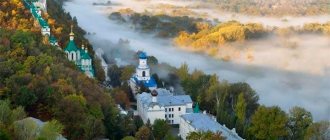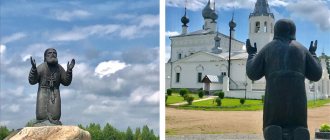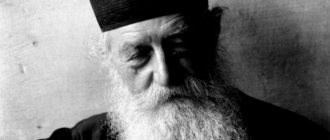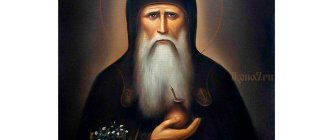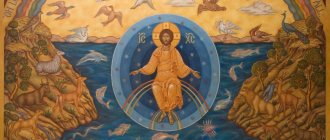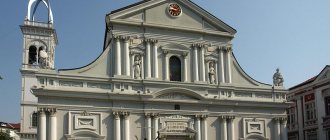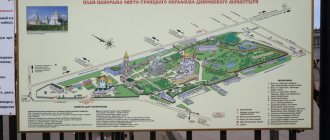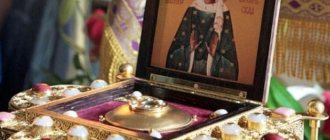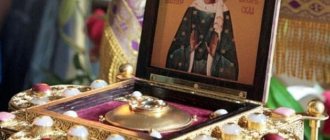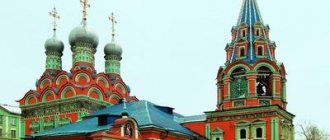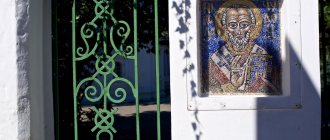| Moscow Church of St. Nicholas the Wonderworker in Kotelniki |
Moscow Church in the name of St.
St. Nicholas the Wonderworker in Kotelniki , a metochion of the Orthodox Church in the Czech lands and Slovakia
- Thrones: St. Nicholas the Wonderworker, St. Zosima and Savvaty Solovetsky, prmts. Evdokia Iliopolskaya
- Address: Russia, Moscow, 1st Kotelnichesky lane, 8
- Website of the representative office of the Czechoslovak Church:
- On the map: Yandex.Map, Google map
Located in one of the most picturesque places in Moscow - on the steep slope of Shvivaya Gorka.
On the site of the St. Nicholas Church in the ancient Kotelnaya Sloboda in the 17th century there stood the wooden Church of the Life-Giving Trinity (first mentioned in 1547). In 1657, the temple was rebuilt in stone, and in 1688, at the expense of the Stroganov parishioners, a new temple with the chapel of the Venerable Zosima and Savvaty Solovetsky appeared on the same site. Nicholas Church became the estate church of the Stroganov barons with a family tomb. After the fire of 1812, the family church with an almshouse was restored at his own expense in 1822-24 by the only heir of the Stroganovs in Moscow, Prince Sergei Mikhailovich Golitsyn.
The temple was consecrated on August 24, 1824. In the name of the renewed church, Prince Golitsyn deposited 30 thousand rubles in banknotes into the safe treasury for eternal storage. Annual interest on the amount was awarded to the priest with the clergy.
In 1833, a stone one-story almshouse with a mezzanine was built at the temple, where at first 10 “female” people were kept.
| Moscow Church in the name of St. Nicholas the Wonderworker in Kotelniki, 1872 |
In 1873, the widow of the deacon Evdokia Egorovna Vinogradova, at her own expense, built a second chapel inside the church in the name of the Primts.
Evdokia for serving early liturgies in winter. In 1922, the temple was plundered by decision of the “Commission for the confiscation of church valuables from churches in the Rogozhsko-Simonovsky region in favor of the starving people of the Volga region.” Later the temple was closed, beheaded, and the church decoration was lost.
Until 1990, the temple building was occupied by the Moscow geological and hydrogeological expedition of the Tsentrogeology PTO of the USSR Ministry of Geology. In addition, in the clergy house there were various departments of the Research Institute of Animal Morphology named after. Severtsev, including a bird ringing center. Inside, the building was divided into three floors; in the altar there was the office of the head of the geological expedition; not a trace remained of the frescoes.
In the 1970s tidied up the appearance of the temple.
In 1992, the temple was returned to believers, and services were resumed there. Over the next decade, it was restored to its original appearance, and the iconostases and wall paintings were restored inside.
On October 28, 1998, the temple was consecrated by Patriarch of Moscow and All Rus' Alexy II.
In 1999, a representative office of the Orthodox Church of the Czech Lands and Slovakia in Moscow was opened in the revived church.
In November 1999, Patriarch Alexy II and Metropolitan Dorofey (Philip) performed the great consecration of the temple.
Architecture and decoration
The building project belongs to the architect O.I. Bove, during implementation was slightly changed by the architect D.I. Gilardi in the late Empire style. The building consists of a rotunda-type temple on a quadrangle with a semicircular apse, a small refectory and a 2-tier (with tiers rectangular in plan) bell tower. The asymmetrical composition, which dates back to the traditions of the 17th century, is apparently associated with the use of the foundations of an earlier church built by the customer’s ancestors, the Stroganovs, who had long lived in this parish. The church is located on the slope of Shviva Hill and is designed to be viewed both from the river bank and from the alley running along its facade.
In 1873, a high porch was erected on the west, in front of the entrance. At the same time, a chapel to St. Eudoxia was built in the refectory. The decoration of the facades of the monument combines the rigor and clarity of lines characteristic of the late Empire style with crushed, fractional modeling of some details. Facing the alley, the southern facade of the quadrangle of the temple is accented by a flat four-pilaster portico, completed by a pediment, and in the spaces between the pilasters above the windows there are wonderful high-relief compositions: “Entry into Jerusalem”, “Adoration of the Magi” and “Massacre of the Innocents”. The walls along the perimeter of the building are surrounded by a wide frieze, which includes triglyphs and metopes, decorated with carefully crafted stucco medallions, on the quadrangle of the temple and the lower tier of the bell tower. The Ionic capitals of the pilasters decorating the rotunda of the temple and the upper tier of the bell tower are distinguished by an equally delicate pattern. The two-story brick clergy house, preserved on the site next to the church, was rebuilt in Empire forms in the 1840s. from a one-story almshouse building with a mezzanine.
Four hundred Lyudmils on the patronal holiday
“Orthodox Moscow” continues to introduce readers to the representations of Local Churches in our city. Today we are going to the Church of St. Nicholas in Kotelniki, where we will find out about the traditions of the Orthodox Church of the Czech Lands and Slovakia.
Hundreds of women named Lyudmila gather in this temple on September 29. They flock here not only from all over the capital, but also from the near Moscow region and other regions of the country. On this day, the patronal holiday is celebrated here - the day of the holy martyr Lyudmila, Princess of Bohemia.
— At the Divine Liturgy on September 29, approximately four hundred Lyudmilas gather in our church. And when each of these women approaches Communion, you don’t even have to ask for their name,” says with a smile the rector of the Church of St. Nicholas in Kotelniki, the representative of the Orthodox Church of the Czech Lands and Slovakia under the Patriarch of Moscow and All Rus', Archimandrite Seraphim (Shemyatovsky). “Every year we prepare for this holiday with great diligence and try to bring even more national flavor to it. Well, the most important thing is that believers on this day can participate in the bishop’s service.
— Your church is the only one in the Russian capital where the relics of the holy martyrs Princess Lyudmila and Prince Vyacheslav of Czech reside. Believers will be able to worship them during the festive service. How did these shrines appear in the Moscow church?
— Firstly, I would like to note that it is possible to venerate the ark with particles of the relics of these saints on any day. They are kept in the altar, but anyone can turn to the clergy of the temple, and the relics will definitely be brought out to him!
Church of St. Nicholas of Myra in Kotelniki - Metochion of the Patriarch of Moscow and All Rus', Metochion of the Orthodox Church of the Czech Lands and Slovakia
These are the main shrines of the St. Nicholas Church. They were given to us shortly after the opening of the metochion in 1999 by His Beatitude Metropolitan Dorofey of the Czech Lands and Slovakia. Two months before the Lord called him from earthly life, he came to Russia to, together with Patriarch Alexy II, perform the great consecration of our temple.
— Other shrines are kept in the St. Nicholas Church. For example, upon entering the temple, on the right side, believers are greeted by a small Kazan Icon of the Mother of God with a darkened face. It is framed in a large beautiful frame...
“It was once discovered at the site of a burnt house. According to eyewitnesses, after the fire not a single object remained intact, and only the holy image lay untouched. The icon was transferred to our church, and now it is one of the revered shrines.
— The Church of St. Nicholas the Wonderworker in Kotelniki was built in the first half of the 19th century by the famous architect Osip Bove on the site of a wooden church that once stood here. Do you still have any ancient icons?
— Another revered image is the icon of the Most Holy Theotokos of Feodorovskaya. This is the only icon that survived after the destruction of the temple during the hard times. As you know, St. Nicholas Church was closed in 1930. At that time, its rector was Archpriest Nikolai Chertkov, who served in our church for more than 30 years. It is known that he went to the Lord on the night when the security officers were supposed to arrest him. The priest’s daughter carefully kept the icon, expecting that one day the temple would be opened again. One can imagine how this woman’s family risked their lives and freedom during times of persecution! When the Church of St. Nicholas in Kotelniki began to be revived, in the early 90s, Irina Nikolaevna Chertkova returned the shrine to the temple.
—Are there many Czechs and Slovaks among your parishioners?
- Units. These are mainly students who study in Moscow. We support them as much as we can. But the proximity of the “high-rise” on Kotelnicheskaya embankment has its influence. Among the parishioners there are truly legendary people - politicians, actors of the main theaters of the country. They don't like to advertise themselves. Our temple is a place where they can attend worship services without attracting attention. We have few parishioners: we are located far from residential areas and the metro, many believers come here specifically for worship. The atmosphere in the church is always very intimate and friendly. Thus, we will never reprimand a woman who comes wearing trousers or short sleeves. I think the parishioners like the singing of our singers, because many of them are soloists of the famous ensemble of ancient Russian sacred music “Sirin”, which is based in our courtyard and has already become an integral part of the community.
— How do services in churches in the Czech Republic and Slovakia differ from ours?
— Orthodox Christians in Slovakia in most cases do not have professional liturgical choirs. The entire service is sung by the parishioners themselves, led by the so-called cantor - the lead singer. Everyone knows the chants from childhood, they are simple and they are very similar to the Old Believer chants of the 17th century. this style of worship and singing is still preserved in Slovakia. Recently, however, choirs have begun to be organized at cathedrals, since many musicians studied in Russia, Serbia, and Greece. Thanks to this, it is possible to note the diversity of singing at divine services. For example, in Michalovce, a small town in eastern Slovakia, the early liturgy is celebrated with a choir, where works by Tchaikovsky and Bortniansky can be heard. During the late liturgy the people sing. I will add: Orthodox Slovaks (unlike the Czech Republic, where they serve in both Czech and Church Slavonic) pray in Church Slavonic.
— Is it possible to bring the traditions of the Orthodox Church of the Czech Lands and Slovakia to the Moscow courtyard?
— Moscow has its own tradition of church singing, which is very important to preserve, but we try to perform certain chants in the entire church. His Holiness Patriarch Kirill also blessed the creation of folk choirs. We distribute the text of Psalm 33 to our parishioners and sing it together. We hope that the courtyard will become a meeting place not only for parishioners of the temple, but also for everyone who wants to touch the traditions of the Russian Orthodox Church, as well as learn more about the culture and life in the Czech Republic and Slovakia.
Church of St. Nicholas in Kotelniki
Nicholas the Pleasant is a saint who helps everyone who prayerfully turns to him for help. It is believed that He especially favors those who travel. And since Linda and I invite everyone on a big trip around Moscow, I think I’ll start with my favorite Church of St. Nicholas in Kotelniki. With God's help and under His guidance.
The history of the Church of St. Nicholas in Kotelniki is closely connected with the family of the famous merchants Stroganov, who were considered the richest people in Russia, and the successor of the Stroganov family, Prince Sergei Mikhailovich Golitsyn.
Over its centuries-old history, the temple was rebuilt several times. The appearance, name, and decoration changed, but St. Nicholas Church always remained the center of the spiritual life of Moscow merchants and craftsmen.
The long history of the temple dates back to several periods: on the site of the temple in the 17th century stood the wooden Church of the Life-Giving Trinity (first mentioned in 1547 ). Later, renamed the St. Nicholas Church, it became the estate church of the Stroganov barons with a family tomb, and after the fire of 1812, the family church with an almshouse was restored at his own expense by the only heir of the Stroganovs in Moscow, the first Moscow barin - Prince Sergei Mikhailovich Golitsyn.
Stroganov period At the end of the 17th century, in connection with the abolition of craft settlements and the disbandment of the Streltsy, Taganny Hill began to attract the attention of wealthy merchants - it was located in close proximity to the city. It was at this time that the famous explorers of the Perm region and Siberia, the richest salt industrialists in Russia - the Stroganovs, acquired property here “for stops on trade and government affairs.”
Most historians believe that the Stroganov family originates from Novgorod the Great. Although the most authoritative researcher of their pedigree, A. A. Vvedensky, believes that they come from Pomeranian peasants. Historians compare this famous dynasty both with the richest German bankers of the late 15th and 16th centuries, the Fuggers, and with the Spanish condottieri Pizzaro and Cortes, who conquered American lands. However, the scale of the Stroganovs' activities was disproportionately greater. In addition to the development of new territories and the development of their own crafts, they constantly provided support to the state: they provided the royal house with various kinds of goods, presented the court with rich gifts and provided funds free of charge, which in turn was returned to them a hundredfold in countless privileges. Their possessions could rightfully be considered a kingdom. In this “kingdom” of one hundred thousand square kilometers, which is larger than the territory of some European countries, the Stroganovs had their own army - such a rare phenomenon even for the boyars, their own industry - iron production and salt boiling, and even their own foreign trade - trade in sable skins mined indigenous peoples of the Urals and Trans-Urals.
On their lands, the Stroganovs built shipbuilding sites and opened tanneries - manufactories for their own needs, and organized a pearl fishery. The squads at the disposal of the Stroganovs were not only able to protect them from attacks by hostile tribes, but also allowed them to make forays into adjacent territories. They equipped the Volga Cossack Ermak for a campaign against the Siberian kingdom. Raids from this kingdom constantly worried the inhabitants of the Russian north. As a reward for taking the capital of the Siberian kingdom, Tsar Ivan the Terrible granted the Stroganovs the right to duty-free trade in the newly conquered lands.
During the Time of Troubles, the Stroganovs did not take any part in coups d'etat, but in 1609 they took the side of Tsar Vasily Ivanovich Shuisky, whom they helped with both money and their squad. For this, in 1610, the tsar thanked them with lands, various benefits and ordered that Andrei, Peter, Nikita, and Maxim Stroganov be written in letters with “vich,” that is, by name and patronymic. This meant that the Stroganovs became “eminent people,” along with the boyars and okolnichy, and could enjoy many privileges, for example, only the tsar could judge them personally. There was even a separate article in the Council Code of 1649, which established the rights of the Stroganovs and emphasized the peculiarity of their position in the state.
The Reverends Zosima and Savvaty, the Solovetsky miracle workers, were especially close to the Stroganovs, widely revered in the Pomeranian region. There is an assumption that they personally knew the Monk Zosima, who went to Veliky Novgorod to the Metropolitan and other noble people with a request to give the Solovetsky Islands into the possession of the monastery he founded. So, in 1688, the Stroganovs completely renovated the Trinity Church in Kotelniki and built a new chapel for Sts. St. Zosima and Savvaty Solovetsky.
Grigory Dmitrievich Stroganov was born in 1656, he was the only son of Dmitry Andreevich, and the last “famous person”. Grigory Dmitrievich received an excellent education for that time and from early childhood helped his father in economic matters. From the age of sixteen, he already participated in official government embassy receptions in the Kremlin Palace, and was present at royal and patriarchal feasts. It was about him that people made up a saying: “You won’t be richer than Stroganov!”
The house of Grigory Dmitrievich on Shvivaya Gorka (Tagan Hill) stood, as befits the house of an eminent person, on the very edge of the hill, being a landmark of that time, and was famous throughout the area for its hospitality and hospitality and was open “not only to his friends, but also to all ranks.” people." With everyone, according to contemporaries, Grigory Stroganov was “kind and affectionate, but the poor was a prospector.” During the Northern War, Grigory Dmitrievich actively supported the initiatives of Peter I, building several ships. For services to the fatherland, and as a sign of personal favor, the “eminent person” Grigory Dmitrievich Stroganov, Peter I granted a medallion with his own image to wear on his chest. The royal privileges also extended to the family of Grigory Dmitrievich - for example, his wife Maria Yakovlevna received the right to wear Russian dress, which was practically impossible at Peter's court, and with the ban on house churches, her sons were allowed (by personal decree of Peter I) to arrange one at the Stroganov house in Moscow.
On the day when the Orthodox Church celebrates the twelfth feast of the Entry of the Most Holy Theotokos into the Temple, November 21 (Old Style), 1715, Grigory Dmitrievich rested in the ancient church graveyard at the Church of St. Nicholas in Kotelniki. With his death, the era of “famous people”, the glorious time of merchants and industrialists, ended, and a new one began - barons and counts, capital residents, aristocrats, patrons of the arts.
Marya Yakovlevna (née Novosiltseva) died 19 years after the death of her husband in 1734 and was buried near him. The tradition of Marya Yakovlevna's charity was inherited by her daughter-in-law - the wife of Baron Alexander Grigorievich Stroganov (1698-1754) Marya Artemyevna (1722-1787), nee Zagryazhskaya (in her first marriage - Islentyeva), who in 1759 renovated the women's almshouse at the Church of St. Nicholas.
Until the end of their days, Alexander Grigorievich and Marya Artemyevna lived in their house on the hill. Under them, the temple reached its peak. With their funds, a rich sacristy was collected at the temple. In 1743, a reliquary in the form of a cross was donated to the temple from the Stroganov minister Pyotr Ivanovich Khleboyedov.
Alexander Grigorievich, and his first wife - Baroness Elena Vasilievna Stroganova (died in 1737), nee Mamonova, and the wives of his brothers - Sofya Kirillovna, nee Naryshkina, and Praskovya Ivanovna, nee Buturlina, rested in the crypt at the Church of St. Nicholas, as evidenced by the cast iron slabs above their burial sites right up to its destruction. Church of St. Nicholas in Kotelniki in Moscow became the family tomb of the Stroganovs. Unfortunately, with the death of Alexander Grigorievich and his wife, the Muscovite Stroganov family ceased to exist: the couple had no sons, their daughters got married, and the sons of his brothers moved to the capital St. Petersburg.
Golitsyn period However, everything soon changed. On April 22, 1816, Princess Anna Alexandrovna Golitsyna, née Baroness Stroganova, daughter of Alexander Grigorievich, died, leaving from her marriage to Lieutenant General Mikhail Mikhailovich Golitsyn (1731-1804) a son, Sergei Mikhailovich (1774-1859). In memory of his mother and her parents, his grandfathers and great-grandfathers, Sergei Mikhailovich, as the only heir of the Stroganovs in Moscow, decided to restore the temple over his family tomb and revive the almshouse. In 1818, he submitted a petition to the Most Reverend Augustine, Metropolitan of Moscow, asking for the restoration of the church.
In the affairs of the Moscow Spiritual Consistory, preserved in the archives of Moscow, we find the following entry: “December 1818, 21 days. The Privy Councilor, Acting Chamberlain and Cavalier, Prince Sergius, Prince Mikhailovich Golitsyn, announced to the late Right Reverend Augustine with a petition: Ivanovo forty, the Church of St. Nicholas the Wonderworker, called in Kotelniki, has recently fallen into disrepair, and during the enemy invasion there was a fire in the exterior and looting suffered, but since this church was built by the support of his ancestors, the Barons Stroganovs, and their bodies are buried in it, then she wants to correct it in everything and bring it into splendor with her sum ... " was built with all the splendor and “in the decency of other churches of the saints. And all the things necessary for its consecration and priestly service” were acquired...
The new, stone, Empire style church, with a single-tier bell tower above the porch, designed by the famous architect Osip Bove, was “covered with iron painted with green paint...” The recreated “Stroganov temple” was consecrated by Metropolitan Philaret (Drozdov).
This significant event took place in 1824. Prince Sergei Mikhailovich provided the maintenance of the clergy, and he himself began to petition for the appointment of rector of the temple. This was priest John Alekseevich Blagoveshchensky, who graduated from the Moscow Theological Seminary in 1820. In the name of the renewed church, Prince Golitsyn deposited 30 thousand rubles in banknotes into the safe treasury for eternal storage. Annual interest on the amount was awarded to the priest with the clergy. In the stone one-story almshouse with a mezzanine, built in 1833, at first 10 “female” people were kept. There were also free rooms that were rented out for the benefit of the almshouse. Later, in the statement about almshouses dated January 1, 1876, it was said that the almshouse “at the Nikolaevskaya Church in Kotelniki” was in good condition, and the contents intended in addition to the capital donated for eternity by Prince Golitsyn “received from willing donors” - Messrs. Pashkov and Ivanov .
In 1873, the widow of the deacon Evdokia Egorovna Vinogradova, at her own expense, built a second chapel inside the church in the name of the Primts. Evdokia for serving early liturgies in winter. And in 1897 the temple solemnly celebrated its double anniversary. This year marks 350 years since the glorification of St. Zosima and Savvaty at the Moscow Council in 1547, as well as 200 years since the construction of the chapel named after them. On this solemn note, the “Golitsyn” period in the life of the Church of St. ended. Nicholas in Kotelniki.
Temple shrines at the beginning of the 20th century By the beginning of the 20th century in the church of St. Nicholas in Kotelniki, icons of the 17th century were preserved. So, in the iconostasis of the chapel of St. Zosima and Savvaty there was an icon of the Kazan Mother of God with an inscription on the silver frame below: “The true image and copy of the miraculous image that is known as Smirnykh in the city of Kaluga, and was written by the isographer Afanas.” In the same chapel was placed the Icon of the Vladimir Mother of God “with miracles in a robe, strung with pearls in a gilded silver frame, placed in an icon case behind glass,” and in the iconostasis of the chapel there was a prmts. Evdokia had an icon of the Theodore Mother of God with the image on its margins of the Great Martyrs Theodore and Andrei Stratelates. Temple shrines were considered “four altar crosses, silver, gilded, with particles of relics.” One is of chased work, on the upper side there is an image of the crucifixion, on the sides there are four standing ones, at the bottom there is St. Nicholas. Under the image of the saint there is an inscription: “1743.” Below we read: “This Life-Giving Cross is attached to the Church of St. Nicholas the Wonderworker, in Kotelniki. The House of the Most Excellent Barons Stroganov is served by Petr Ivanovich Khleboedov.”
Of the former splendor of the temple, after its destruction, only one shrine remained: the icon of the Feodorovskaya Mother of God. It was preserved by the daughter of the last rector, Fr. Nikolai Chertkova, the late Irina Nikolaevna Chertkova.
Priest Nikolai Feoktistovich Chertkov served in the Church of St. Nicholas has been in Kotelniki for almost 30 years. During his ministry, the most tragic pages of temple history occurred. In 1922, by decision of the “Commission for the removal of church valuables from the churches of the Rogozhsko-Simonovsky region in favor of the starving Volga region,” the Church of St. Nicholas in Kotelniki, along with other churches of Tagannoy Hill and Rogozhskaya Sloboda (such as, for example, the Church of Martyr Nikita beyond the Yauza, the Assumption in Gonchary, the Savior in Chigasy, St. Basil the Confessor and St. Sergius of Radonezh in Rogozhskaya Sloboda, St. Nicholas on Yamy and some others) were subjected to real barbarian raids...
Our days Until 1990, the temple building was occupied by the Moscow geological and hydrogeological expedition of the Tsentrogeology PTO of the USSR Ministry of Geosciences. In addition, in the clergy house there were various departments of the Research Institute of Animal Morphology named after. Severtsev, including a bird ringing center. According to eyewitnesses, “the outside perimeter of the building was so covered with earth that it had to be dug out, and from the window of the central portal one could easily go out onto the street.” During excavations, human remains were found, presumably also the remains of burials from the Stroganov tomb. The tomb itself was located on the site of today's refectory; it was there that ancient tombstones were dug up during the restoration of the temple.
In 1992, the Church of St. Nicholas in Kotelniki was returned to the Russian Orthodox Church. By that time, only the walls remained of the richly decorated temple. Inside, the building was divided into three floors; in the altar there was the office of the head of the geological expedition; not a trace remained of the frescoes.
The first rector of the revived temple was Priest Mikhail Zhukov. He had the difficult task of restoring the temple after decades of neglect. The first services took place literally on a construction site. As parishioners recall, they all took part in the restoration work, men often worked with sledgehammers, women removed garbage and put things in order.
On December 19, 1992, the first liturgy was celebrated on “Winter St. Nicholas” in the Church of St. Nicholas in Kotelniki. With God's help, the efforts of Father Mikhail Zhukov and the church community, the temple was revived, the decoration of the temple was restored.
In 1999, the Church of St. Nicholas in Kotelniki became the Patriarchal Compound and Representation of the Orthodox Church of the Czech Lands and Slovakia under the Patriarch of Moscow and All Russia. In November 1999, His Holiness Patriarch Alexy II and His Beatitude Metropolitan Dorotheos performed the great consecration of the temple. This was the last visit to Russia of His Beatitude Metropolitan Dorotheos, who at the end of December 1999 reposed in the Lord.
In 2000, the first rector of the Czech metochion in Moscow was appointed. He became Protopresbyter Mikhail Dandar. With the opening of the courtyard and the appointment of a new rector, in the context of the previously completed work, the restoration of the Church of St. Nicholas in Kotelniki.
In accordance with the drawings and plans found by the first rector, Father Mikhail Zhukov, at the beginning of the 21st century, the appearance of the temple that this house of God had at the time of its consecration by Metropolitan Philaret (Drozdov) in 1824 was recreated.
In the Church of St. Nicholas in Kotelniki there are particles of the relics of the holy martyrs Lyudmila and Vyacheslav of Czech. This shrine was donated to the Russian Orthodox Church by the Orthodox Church of the Czech Lands and Slovakia and brought from Prague to Moscow in 1999, by the decision of His Holiness Patriarch of Moscow and All Rus' Alexy II, the holy relics were left in the church of St. Nicholas for the prayerful worship of believers. Over time, the celebration of the memory of St. Lyudmila (September 29) turned into a significant spiritual event for all of Orthodox Moscow. The Holy Martyr Lyudmila was a student of Saint Methodius, Equal-to-the-Apostles, and was an educator of the Slavic peoples.
Continuing the Stroganov tradition in the Church of St. Nicholas, concerts of sacred music are held: Christmas, Lenten, Easter carols performed by the ensemble of ancient Russian sacred music “Sirin”.
Temple address: Moscow, 1st Kotelnichesky lane, 8
One-day trip “World Orthodoxy in Moscow”. Part one.
Trip program.The 14 Local Churches can be divided into 3 groups: ancient churches (Constantinople, Antioch, Alexandria, Jerusalem), churches of Orthodox peoples (Serbian, Bulgarian, Cypriot, Greek, etc.), churches of non-Orthodox peoples (American, Chinese, Japanese, etc. .). The excursion will present the courtyards of churches from each group. In this way, a holistic picture of Orthodoxy in the world and in Moscow will be presented.
12-00 Meeting with the guide and departure from Taganskaya metro station.
Antioch courtyard.
Two churches nearby: Archangel Gabriel (“Menshikov’s Bath”), Peter’s architect Zarudny, 1707. Second church: Theodore Stratelates, 1806. Only one of the two churches is open to the public; on weekends, the Church of Theodore Stratelates is usually open during the day. It contains an interesting icon of St. Raphael of Brooklyn with a signature in Arabic. Both churches were practically not closed during Soviet times (they were closed only from 1930-1948, but their decoration was preserved).
Chinese courtyard.
Church of St. Nicholas (Nativity of the Virgin Mary) in Golutvin.
1692. Initially it was the courtyard of the Golutvinsky Monastery in Kolomna (hence the name). It was closed in 1923. Since 2013 it has been a Chinese compound. Albazinians are an Orthodox subethnic group of the Chinese. In the temple there is an interesting icon of the first Chinese Orthodox priest - the Hieromartyr Mitrofan of Beijing (Dzy) and 222 Chinese martyrs with signatures in Chinese. There is also an icon of St. Innocent of Irkutsk, the enlightener of the Chinese. In the courtyard of the temple there is an oriental style garden. Georgian courtyard.
Vmch. St. George the Victorious. One of the few church-monasteries that were built specifically for the Georgian community in the historical Georgian settlement of Moscow back in the 18th century. It acquired its modern appearance during reconstruction in 1899 in the Russian-Byzantine style. It was closed in 1929. Since 1992 it has been restored by the Georgian community. The temple has unusual frescoes made by the artist Kintsuroshvili in the Georgian style. The temple has its own bakery, where you can buy high-quality pastries from Georgian cuisine, a good choice.
American backyard.
Church of the Great Martyr
Catherine on Vspolye. The church was built in 1767 by architect Karl Blank and was built at the expense of Catherine the Great. The appearance of the second Church of the Savior Uncreated was distorted during Soviet times. There were restoration workshops here. In the main church, paintings by Levitsky (an artist from the time of Catherine) have been preserved. At the entrance to the temple there is a memorial plaque dedicated to the first expedition to the Aleuts of North America, which was appointed by Catherine II, which began Orthodoxy in America. There is a shrine in the temple - the shoes of the revered American saint, St. Herman of Alaska. Czech and Bulgarian farmsteads.
Both farmsteads are located not far from each other in the Taganka area.
Compound of the Czech Lands and Slovakia
in the church of St.
Nicholas in Kotelniki 1824 by the famous architect Osip Bove (Teatralnaya Square, facade of the Bolshoi Theater, etc.) in the Empire style. The church was built at the former Stroganov estate. At this parish, in the church that preceded the current one, Dostoevsky’s great-grandfather, Mikhail Kotelnitsky, served as a priest. Since 1998 Czech courtyard. Revered icons of St. Ludimly and St. Vyacheslav Czech, every Wednesday an akathist to St. Lyudmila. On the territory of the temple a monument to St. Lyudmila Czech. Bulgarian courtyard
in the Church of the Assumption in Gonchary. 1654. The tiles of Stepan Polubes have been preserved. It has never been closed, since 1948 it has been a metochion of the Bulgarian Church. The shrine is the icon of the Three Hands. In the narthex there is a large icon of the Cathedral of Bulgarian Saints.
The tour ends at approximately 18-30 M. Taganskaya
